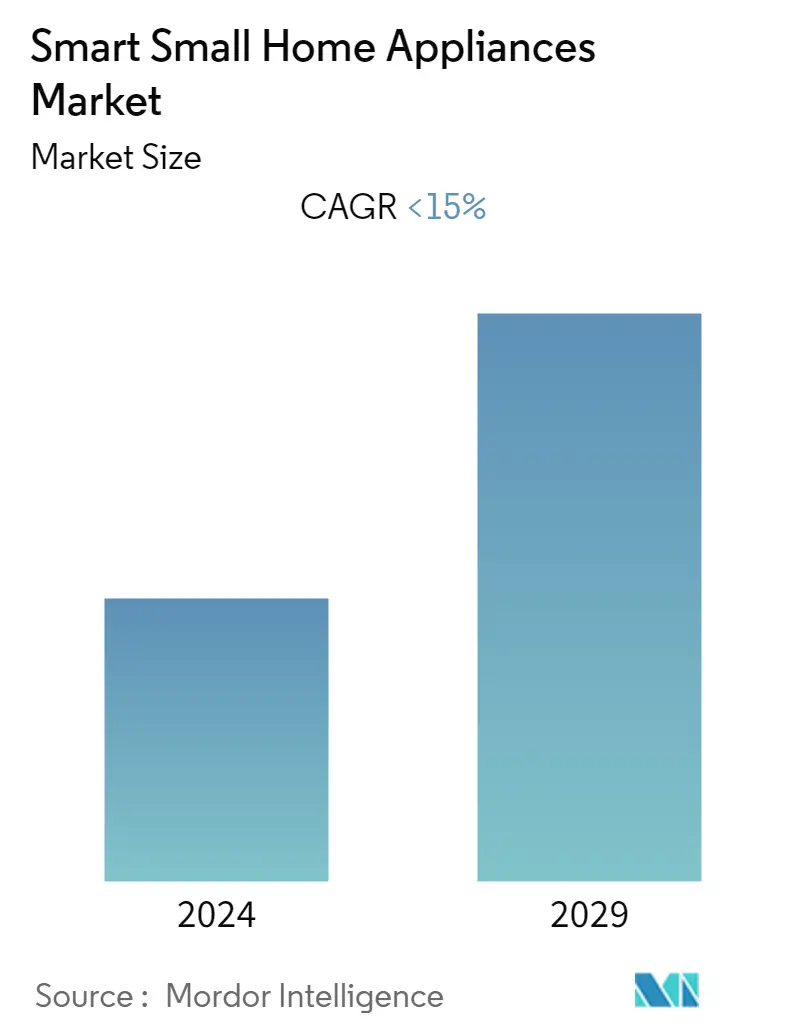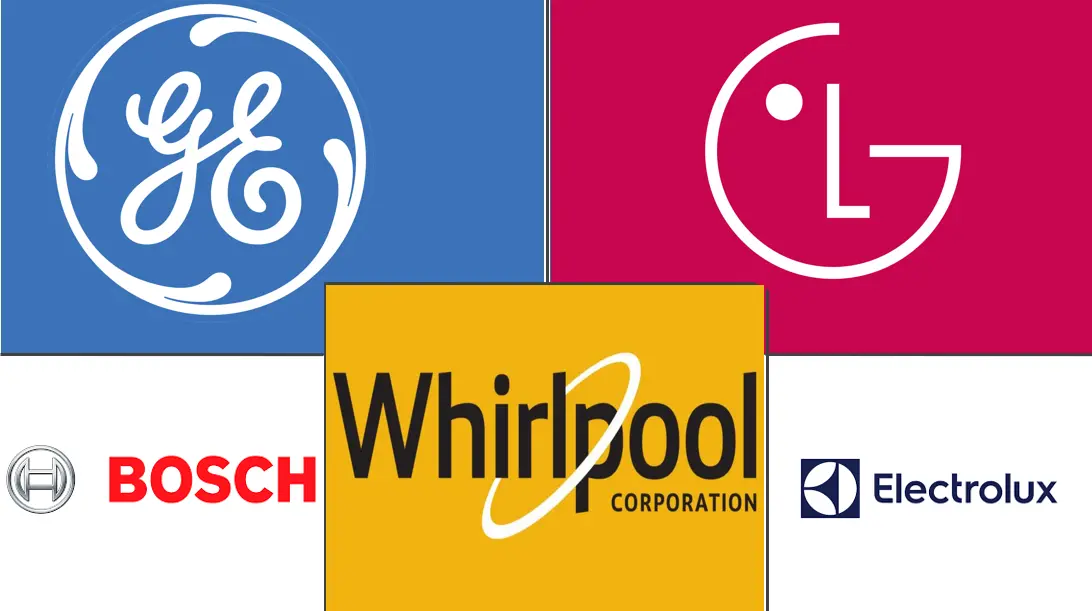Market Size of Smart Small Home Appliances Industry

| Study Period | 2020 - 2029 |
| Base Year For Estimation | 2023 |
| CAGR | 15.00 % |
| Fastest Growing Market | Asia Pacific |
| Largest Market | North America |
| Market Concentration | High |
Major Players
*Disclaimer: Major Players sorted in no particular order |
Smart Small Home Appliances Market Analysis
Small Smart Home Appliances are the class of next-generation connected equipment that are designed to be controlled with the help of commands from a central system or communicate with other appliances in a network and make certain decisions for the owner. The concept of Smart small home appliances, which allow the user to manage everyday home appliances, such as air purifiers, vacuum cleaners, humidifiers, smart coffee makers, etc. with the use of some kind of network, is highly fascinating.
However, the market faces some challenges which are hampering its growth of the market. Some of the major challenges faced by the industry are a lack of consumer awareness and rising privacy threats. Whereas, the market growth would be further supported by various market trends like cloud technology, rising artificial intelligence technology, surging adoption of the Internet of Things (IoT).
The market was impacted by COVID-19 due to reduced manufacturing because of the lockdown being imposed and thus halt in logistics and production in the factories or their assembling. Shift in demand from the residentials because of downfall in one's earnings to the people who were undergoing the Work from Home (WFH)culture and thus demanded smart small home appliances which were making their living and work space easy going together.
Smart Small Home Appliances Industry Segmentation
A complete background analysis of the Smart Small Home Appliances Market, which includes an assessment of the economy, market overview, market size estimation for key segments, and emerging trends in the market, market dynamics, and key company profiles are covered in the report. The Smart Small Home Appliances Market is Segmented by Product Type into Smart Tea/Coffee Maker, Smart Vacuum Cleaner, Smart Air Purifier, Smart Humidifier, and Others, Distribution Channel into Offline and Online, and Geography into North America, Europe, Asia-Pacific, Latin America and the Middle East & Africa. The report offers Market size and forecasts for Small Smart Home Appliances in value (USD Million) for all the above segments.
| By Type | |
| Smart Tea/Coffee Maker | |
| Smart Vacuum Cleaner | |
| Smart Air purifier | |
| Smart Humidifier | |
| Other Products |
| By Distribution Channel | |
| Online | |
| Offline |
| By Geography | |
| North America | |
| Europe | |
| Asia-Pacific | |
| Latin America | |
| Middle- East and Africa |
Smart Small Home Appliances Market Size Summary
The Smart Small Home Appliances Market is experiencing significant growth, driven by the increasing adoption of connected devices that enhance convenience and efficiency in daily household tasks. These appliances, which include air purifiers, vacuum cleaners, and smart coffee makers, are controlled through central systems or networks, offering users the ability to manage their home environment seamlessly. Despite the promising growth trajectory, the market faces challenges such as limited consumer awareness and concerns over privacy. However, trends like cloud technology, artificial intelligence, and the Internet of Things are expected to bolster market expansion. The COVID-19 pandemic initially disrupted the market due to manufacturing halts and logistical challenges, but it also accelerated demand as more people worked from home, increasing the need for smart appliances to improve comfort and productivity.
The Asia Pacific region stands out as the largest market for smart small home appliances, with China and Japan leading due to rising disposable incomes, dual-income households, and lifestyle changes. These factors have facilitated the adoption of AI-based smart appliances, making the region attractive for further investment. The market is consolidated, with major consumer electronics companies like Whirlpool, GE Appliances, and LG dominating by leveraging their technological expertise and early market entry. However, high prices and the need for effective marketing strategies pose challenges for vendors, who are investing in awareness campaigns to expand their customer base. Despite these challenges, the market is poised for continued growth, driven by technological advancements and increasing consumer interest in smart home solutions.
Smart Small Home Appliances Market Size - Table of Contents
-
1. MARKET INSIGHTS AND DYNAMICS
-
1.1 Market Overview
-
1.2 Market Drivers
-
1.3 Market Restraints/ Challenges
-
1.4 Value Chain/ Supply Chain Analysis
-
1.5 Porters Five Forces Analysis
-
1.5.1 Threat of new Entrants
-
1.5.2 Bargaining Power of Buyers/ Consumers
-
1.5.3 Bargaining Power of Suppliers
-
1.5.4 Threat of Substitute Products
-
1.5.5 Intensity of Competitive Rivalry
-
-
1.6 Insights on Consumer Buying Behaviour in Smart Small Home Appliances Market
-
1.7 Insights on Technological Disruption in the Smart Small Home Appliances Market
-
1.8 Impact of Covid-19 on the Market
-
-
2. MARKET SEGMENTATION
-
2.1 By Type
-
2.1.1 Smart Tea/Coffee Maker
-
2.1.2 Smart Vacuum Cleaner
-
2.1.3 Smart Air purifier
-
2.1.4 Smart Humidifier
-
2.1.5 Other Products
-
-
2.2 By Distribution Channel
-
2.2.1 Online
-
2.2.2 Offline
-
-
2.3 By Geography
-
2.3.1 North America
-
2.3.2 Europe
-
2.3.3 Asia-Pacific
-
2.3.4 Latin America
-
2.3.5 Middle- East and Africa
-
-
Smart Small Home Appliances Market Size FAQs
What is the current Smart Small Home Appliances Market size?
The Smart Small Home Appliances Market is projected to register a CAGR of less than 15% during the forecast period (2024-2029)
Who are the key players in Smart Small Home Appliances Market?
Bosch , Whirlpool, LG, Samsung and Electrolux are the major companies operating in the Smart Small Home Appliances Market.

